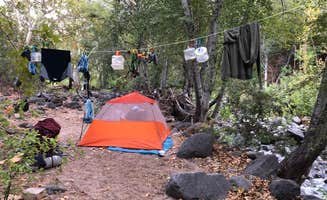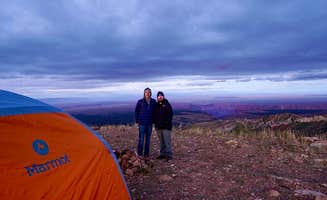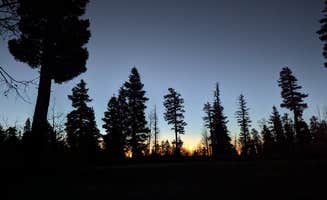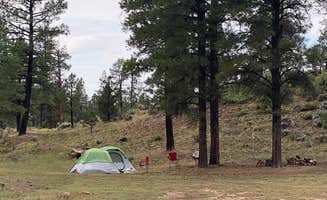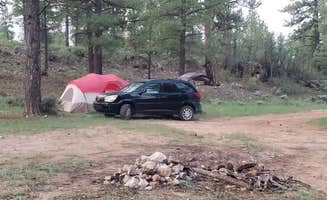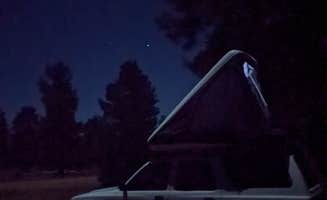Primitive camping near North Rim, Arizona offers visitors solitude in higher elevation forest settings. Camping areas sit between 7,500 and 8,600 feet elevation, creating cooler summer nights than South Rim locations, with temperature drops of 15-30 degrees after sunset. Seasonal access limitations restrict camping primarily from mid-May through October when roads remain passable.
What to do
Hike into the Canyon: The North Rim provides direct access to several backcountry trails. At Saddle Mountain (Kaibab NF), "There is a trail right super close that leads down into the canyon as well," notes Eric E. Hikers can access established trails with varying difficulty levels suitable for day hikes.
Wildlife viewing: North Rim dispersed camping areas provide frequent wildlife encounters. "We had a huge bull elk with his cows walk right past our camp," shares Hugh M. about Forest Service Road 328 Dispersed. Early morning and evening hours offer the best viewing opportunities for deer, elk, and various bird species.
Star-gazing: The minimal light pollution creates exceptional night sky viewing conditions. The open areas away from the denser forest sections provide unobstructed views. "We sat around listening to nature come alive for the day while we made breakfast and charged our battery packs," writes Tiffany S. about the peaceful mornings after star-filled nights at Coconino Rim Road.
What campers like
Secluded camping spots: The distance between sites provides privacy not found in developed campgrounds. At Coconino Rim Road Dispersed Camping, "There are quite a few sites along the FRs and almost all of the sites are very well spaced, most being 0.4 miles apart or more," reports Ray & Terri F. The widely spaced sites allow campers to enjoy natural settings without crowding.
Forest shade: Ponderosa pine forest provides natural cooling during summer days. "Lots of tall junipers to get shade and hang a hammock," notes Jason M. about Kaibab Forest Dispersed FR 682. The tree cover creates comfortable daytime temperatures even during peak summer months.
Canyon-edge sites: Some dispersed areas offer direct rim camping for those with appropriate vehicles. "Our spot was right on the edge of the north rim. Absolutely breathtaking," shares Monte W. about Saddle Mountain. The rim sites provide immediate access to scenic views without driving to viewpoints.
What you should know
Road conditions vary significantly: Forest roads range from well-maintained to extremely rough. "The road is a little bumpy but you do not need a 4 wheel drive to make it," explains Eric E. about Saddle Mountain, while another camper notes, "The road gets really rough" past certain points on FR 611. Road conditions worsen after rainfall.
Limited facilities: Most dispersed areas have no services. "There are no OTA channels to be had with our fixed omni antenna," reports Ray & Terri F. about Coconino Rim Road Dispersed Camping. Campers must pack in all water and supplies and pack out all waste.
Cellular coverage: Signal strength varies across different areas. At Forest Road 611, "AT&T cell service was spotty," reports Sandra W. Other campers note that Verizon typically provides better coverage than other carriers in most dispersed camping areas.
Tips for camping with families
Accessible camping for beginners: Areas closer to main roads provide easier camping experiences. "This is my favorite campground ever! It is so convenient, only 1 mile out from the South Rim entrance of Grand Canyon and was not crowded whatsoever," writes Lauren S. about Long Jim Loop Campground. These areas balance accessibility with natural setting.
Temperature planning: Pack for significant day-night temperature variations. "We camped there in mid June and it was still 39 that night with a nice breeze," reports Tammy G. about Saddle Mountain. Warm clothing for evenings remains essential even during summer months.
Wildlife safety: Educate children about maintaining safe distance from elk and deer. "We were here on 10/17/20 and there were a ton of bugs during the day so a net would've been nice," adds Brittany K. about Saddle Mountain. Bug protection becomes especially important during summer months.
Tips from RVers
Dispersed sites for larger rigs: Several forest roads offer suitable parking for various RV sizes. "I have a 36' Class A with a Cherokee Trailhawk tow and parked and dropped just past the entrance to the NF, then went to scout for a site that would accommodate us," explains Ray & Terri F. about Coconino Rim Road. Pre-scouting routes and sites proves essential for larger vehicles.
Limited turnaround areas: Forest roads often lack wide spots for larger rigs to turn around. "I am usually pretty leery about taking a diesel pusher down forest or mountain roads but this was no problem," shares Robert G. about camping at Grand Canyon North Dispersed on FR 611. Many campers recommend unhooking towed vehicles before exploring potential sites.
Solar considerations: Tree cover affects solar panel efficiency. "Otherwise it's very quiet. From our spot you can see 5 cars, and we are hundreds of yards apart," notes Blake V. about Coconino Rim Road Dispersed Camping. Some campers move after initial setup to find better solar exposure while maintaining privacy.


